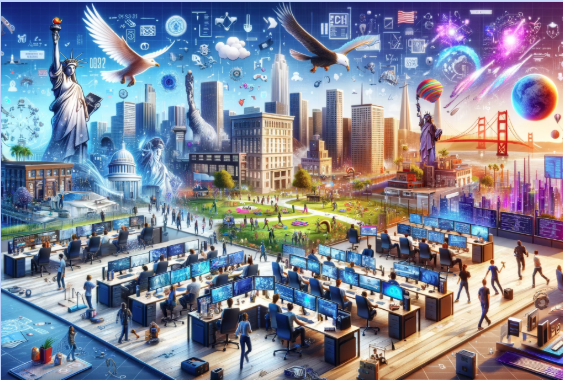In 2025, the gaming industry is not just about creating entertainment—it’s about building ecosystems where creativity, technology, and player expectations intersect. From indie developers experimenting with experimental mechanics to AAA blockbusters redefining realism, one thing is clear: collaboration is no longer optional. The most successful projects today are those where game design companies and a game development studio come together in seamless partnership.
This collaboration isn’t new, but the way it’s evolving in 2025 sets an entirely different tone. Studios and design firms are no longer siloed entities handing over assets back and forth; they are now co-creators, aligned strategically from the very start of a project. Let’s explore how this partnership works today, what challenges it solves, and how it shapes the playbook for the future of interactive experiences.
Why Collaboration Is No Longer Optional
The gaming ecosystem has become far more complex in the past decade. Players demand:
- Cross-platform compatibility.
- Socially engaging mechanics.
- Visually stunning worlds powered by photorealistic 3D and AI-driven animation.
- Consistent updates and live services post-launch.
No single team, no matter how talented, can handle all these moving parts alone. Game design companies specialize in ideation, mechanics, storytelling, and user experience—laying the creative foundation. On the other hand, game development studios excel in engineering, technical execution, pipeline management, and scalable delivery. When these two forces converge, projects can evolve from good to groundbreaking.
The 2025 Collaboration Playbook
So how does this new era of partnership actually work? Here are the guiding principles that define it:
1. Shared Vision From Day Zero
In the past, design often came first, with development following later as an execution layer. In 2025, both design firms and studios are entering projects together from the earliest pitch meetings. This ensures that creative ambitions are balanced with technical feasibility.
Example: A design team might envision a game with persistent weather systems that impact gameplay. By involving the development studio early, the idea can be scoped realistically—leveraging cloud infrastructure, AI, or real-time simulation engines—without ballooning budgets.
2. Co-Creation Pipelines Powered by AI
AI tools in 2025 have become a game-changer for collaboration. Procedural art generation, automated testing, and predictive analytics now form part of the joint toolkit. Rather than replacing artists or developers, these systems act as a shared language between design and development.
For instance, when a design company sketches out a new biome, the development studio can instantly run simulations of lighting, performance, and player navigation—all before any heavy coding begins. This reduces wasted effort and accelerates iteration.
3. Agile and Transparent Workflows
The collaboration playbook thrives on agile methodology, but with an added emphasis on cross-discipline transparency. Teams use unified dashboards that blend creative goals (such as narrative pacing) with engineering KPIs (such as frame rate stability).
Daily stand-ups often include both concept artists and system architects. The result? Fewer bottlenecks and a shared accountability that prevents “design-dev gaps” where ideas fail during execution.
4. Cultural Alignment, Not Just Technical Alignment
Collaboration isn’t purely about skill—it’s about culture. Game design companies often operate with an artistic mindset, valuing narrative, emotion, and creativity. Development studios, on the other hand, prioritize optimization, scalability, and technical innovation.
The 2025 playbook stresses building cultural bridges. Leaders now prioritize empathy, open communication, and hybrid skill sets. Designers are learning the basics of coding logic, while developers are trained to understand user psychology and storytelling.
5. LiveOps as a Shared Responsibility
Gone are the days when the project “ended” at launch. LiveOps—regular content updates, events, patches, and community engagement—is now a central pillar of the gaming economy. In this model, design and development work hand-in-hand even after release.
The design firm may lead ideation for seasonal events, while the studio ensures seamless delivery on servers worldwide. Together, they keep the player base engaged for years instead of months.
Overcoming the Old Challenges
Collaboration has never been without hurdles. In fact, many projects historically collapsed under issues like miscommunication, mismatched timelines, or clashing priorities. But the 2025 playbook addresses these challenges head-on:
- Miscommunication → Unified Platforms: Cloud-based collaboration tools eliminate “lost in translation” issues. Everyone works from the same source of truth.
- Mismatched Timelines → Parallel Development: Teams no longer wait for handovers; iterative builds allow simultaneous progress.
- Clashing Priorities → Shared KPIs: Instead of measuring success differently, both design and development agree on metrics like player retention, monetization health, and community satisfaction.
What This Means for the Future
The collaboration between design companies and development studios is reshaping the very definition of game creation. No longer about handoffs, it’s about synergy. This shift has broader implications:
- For Players: Expect richer, more seamless experiences that balance creative storytelling with technical polish.
- For Businesses: Expect faster go-to-market timelines, more efficient resource use, and higher ROI through player retention.
- For Talent: Expect new hybrid roles—design-developers who can bridge art and engineering fluently.
By 2030, we may even see these partnerships evolve into “super-studios,” joint ventures where the line between design and development disappears entirely.
Final Thoughts
In 2025, success in gaming is less about individual brilliance and more about collaborative genius. When game design companies and a game development studio work as one, the outcome isn’t just a well-built game—it’s an ecosystem that entertains, engages, and endures.
This collaboration playbook isn’t a passing trend; it’s the blueprint for the next decade of gaming innovation. The teams who embrace it early will not only stay competitive but will also set the tone for how games are imagined, built, and experienced worldwide.


